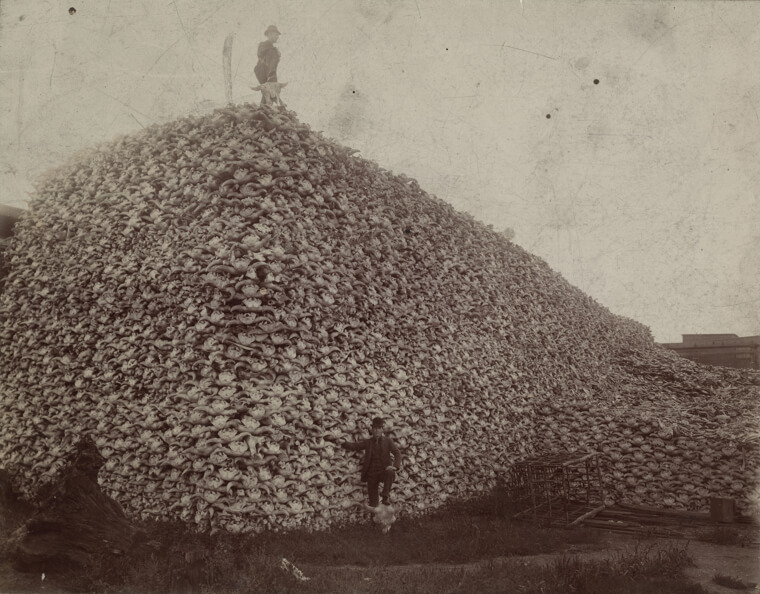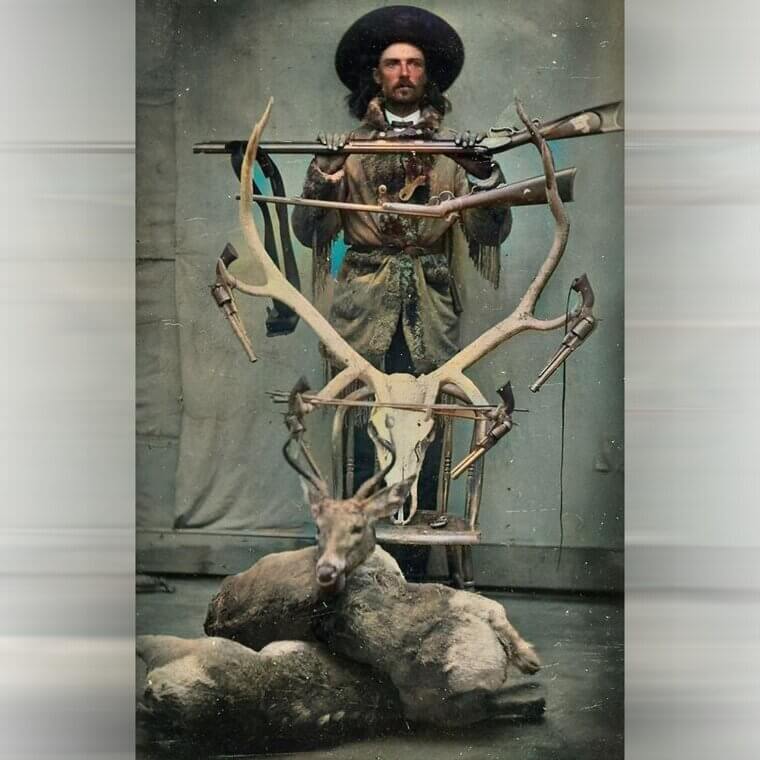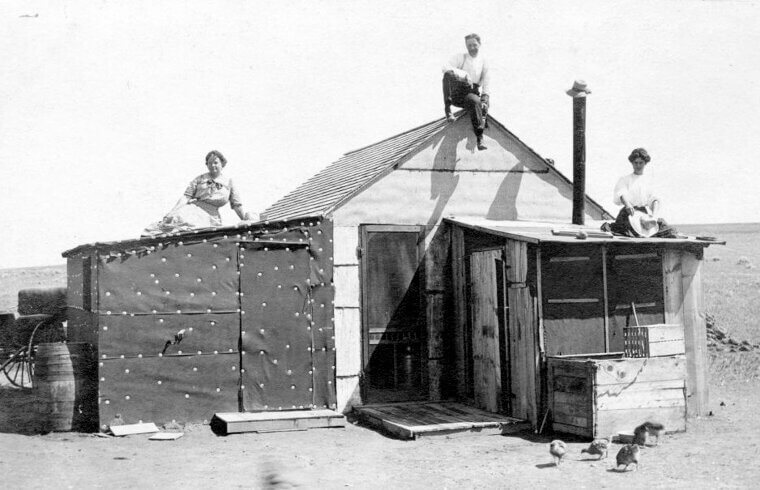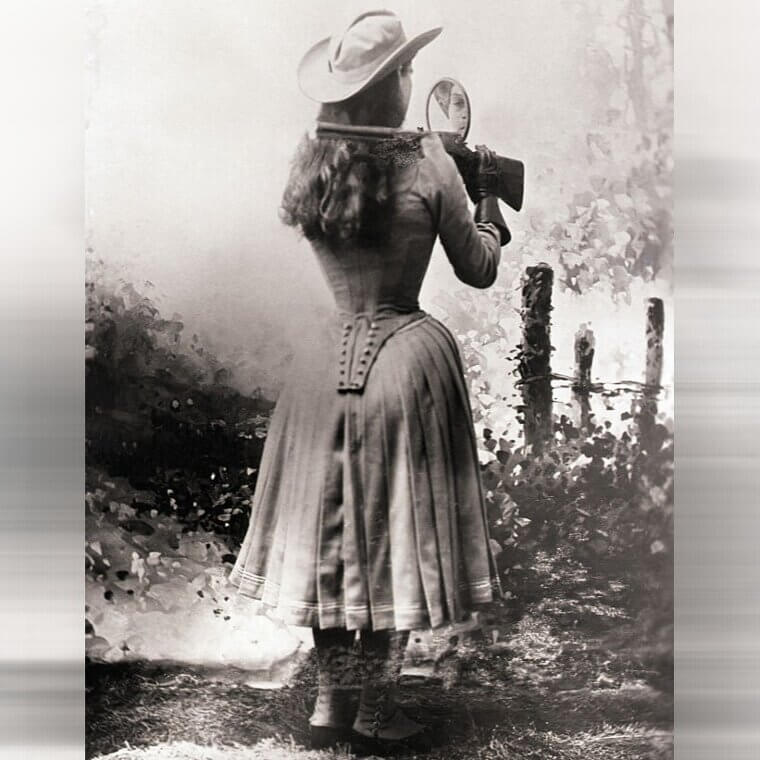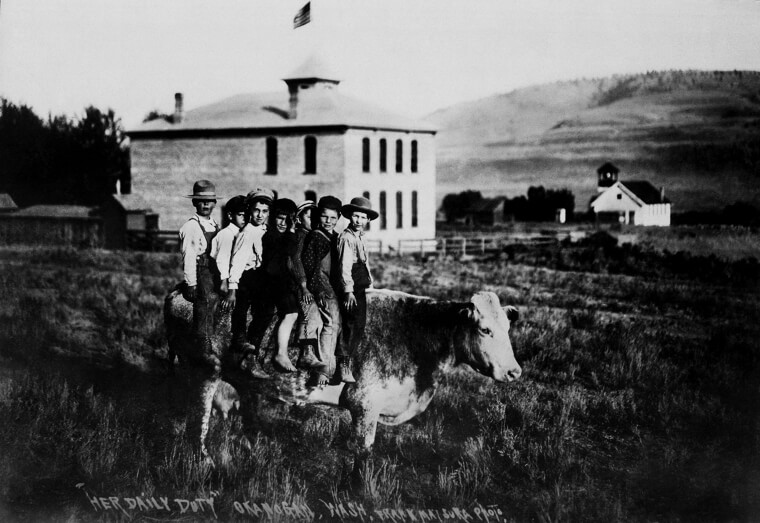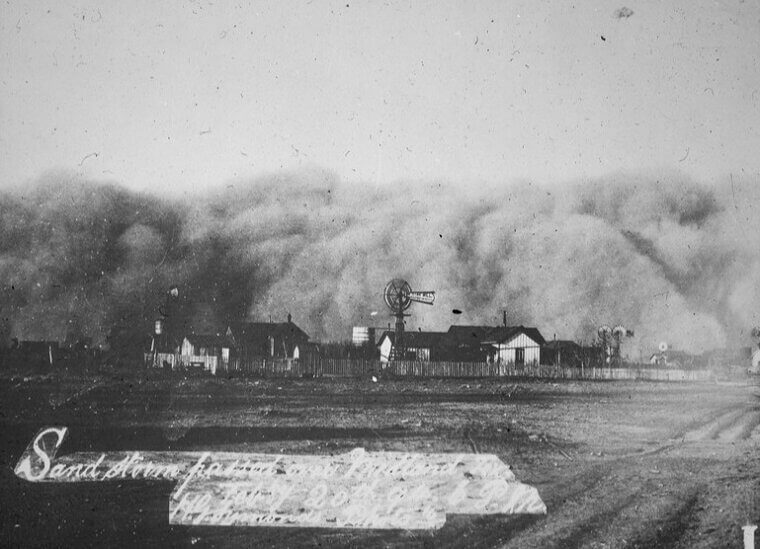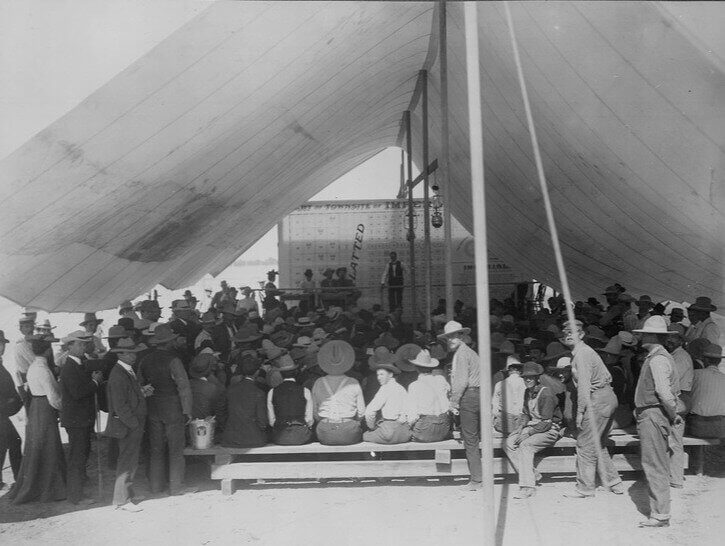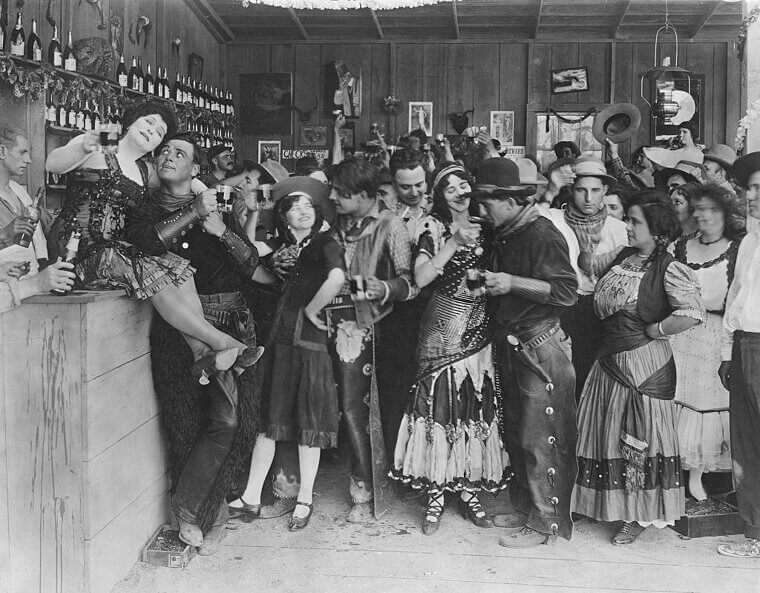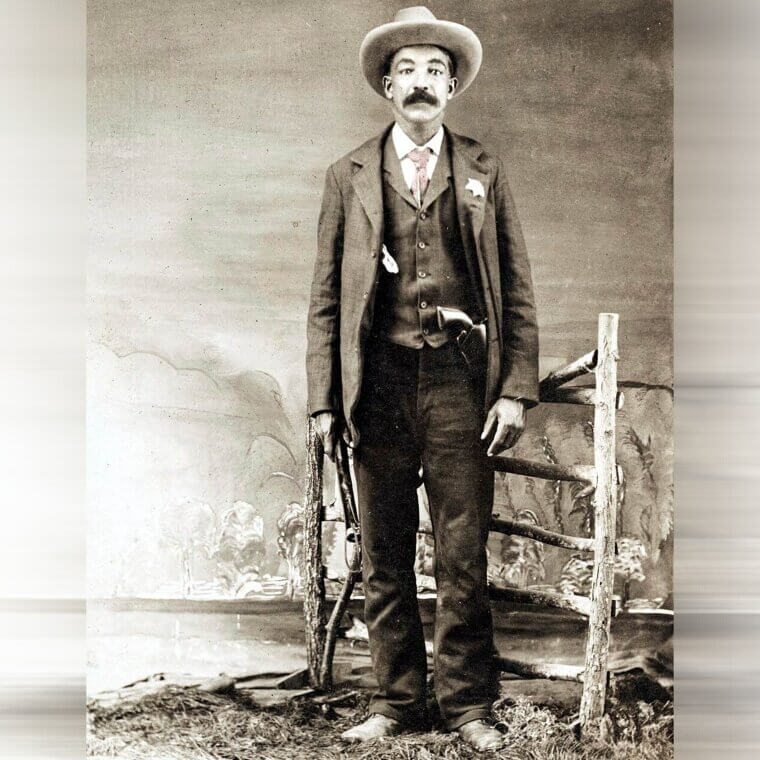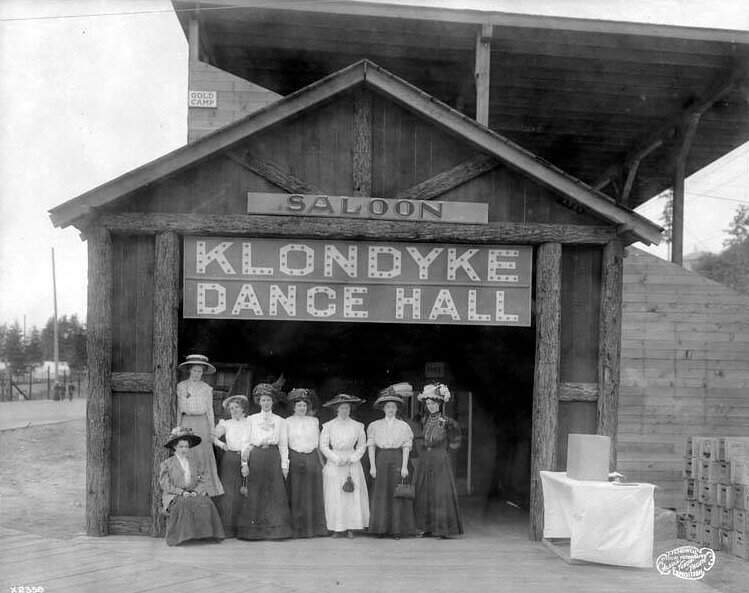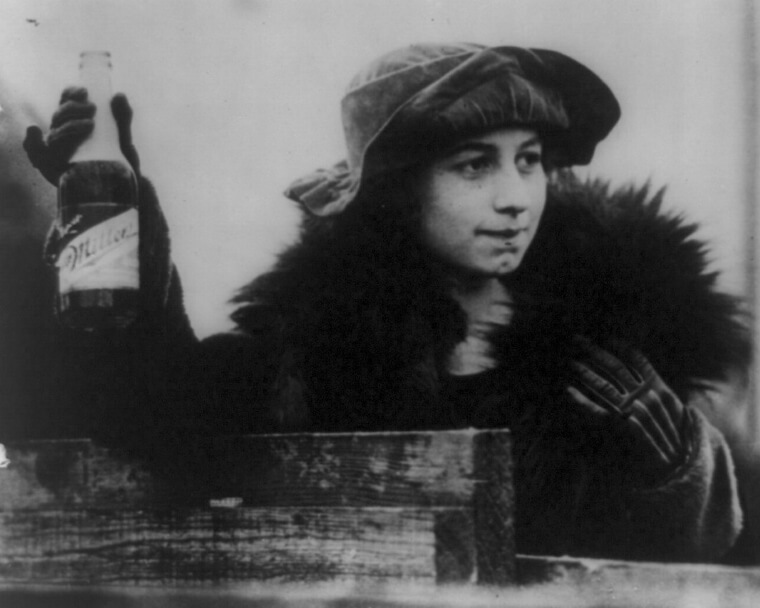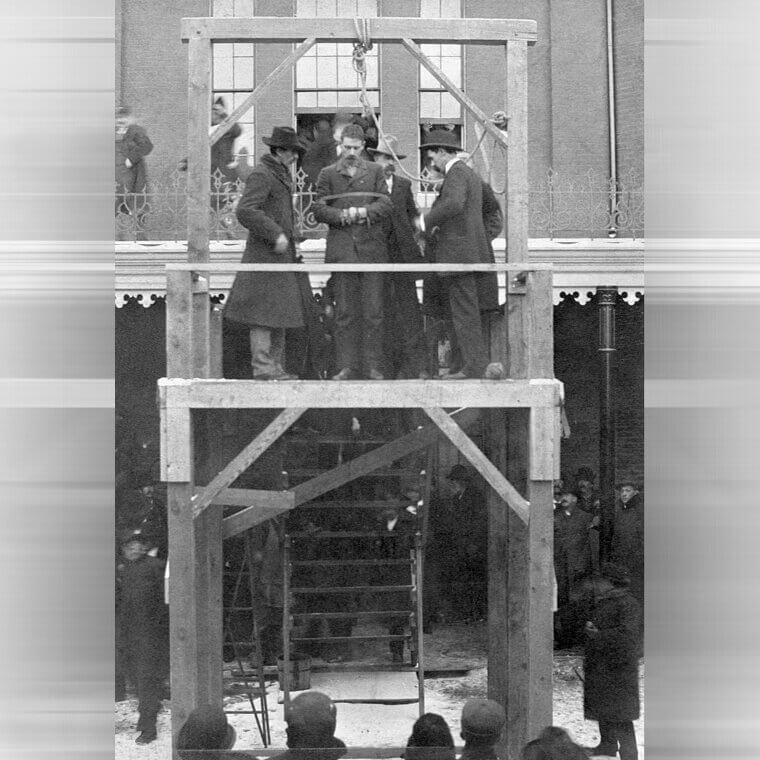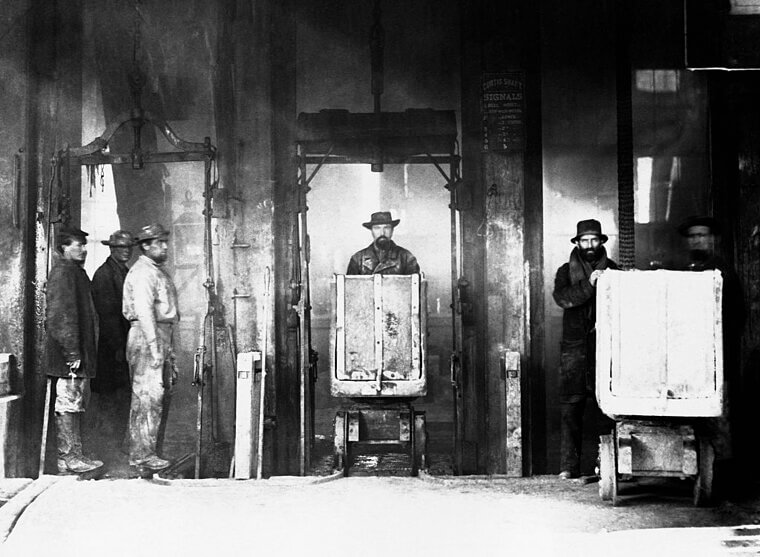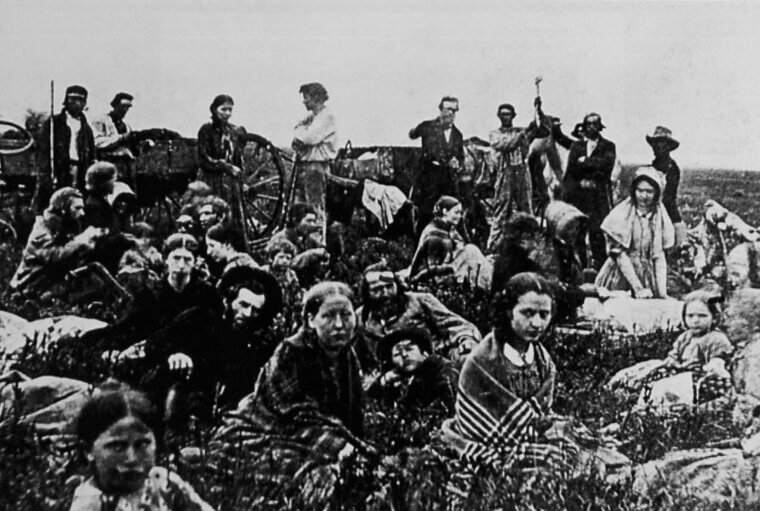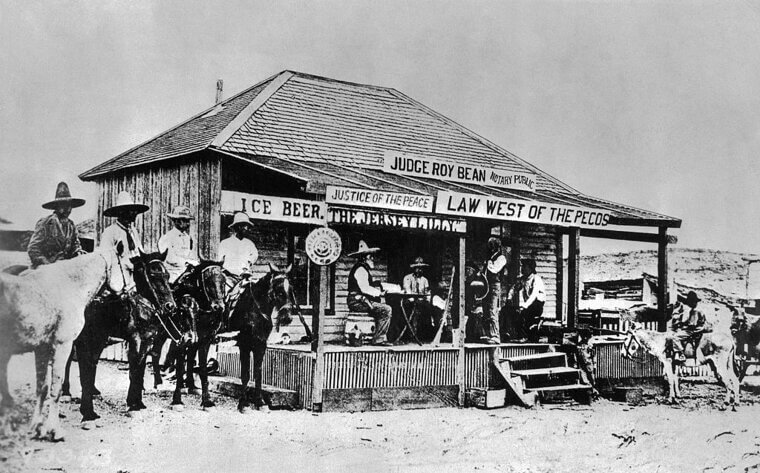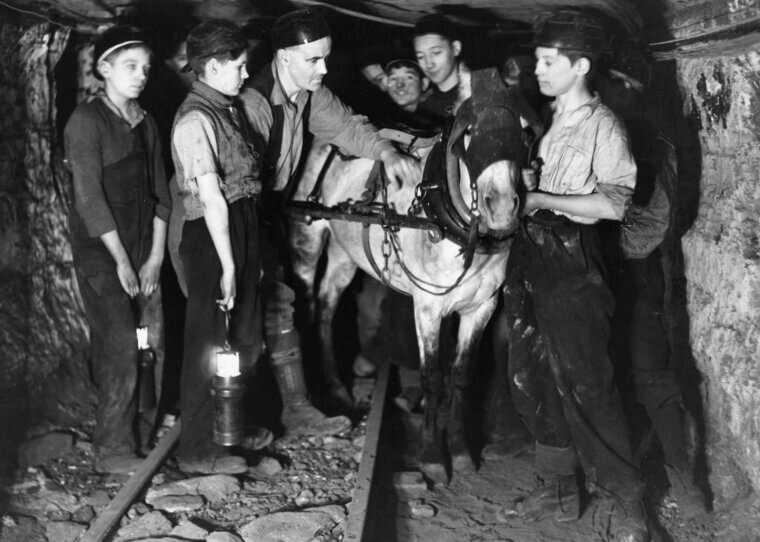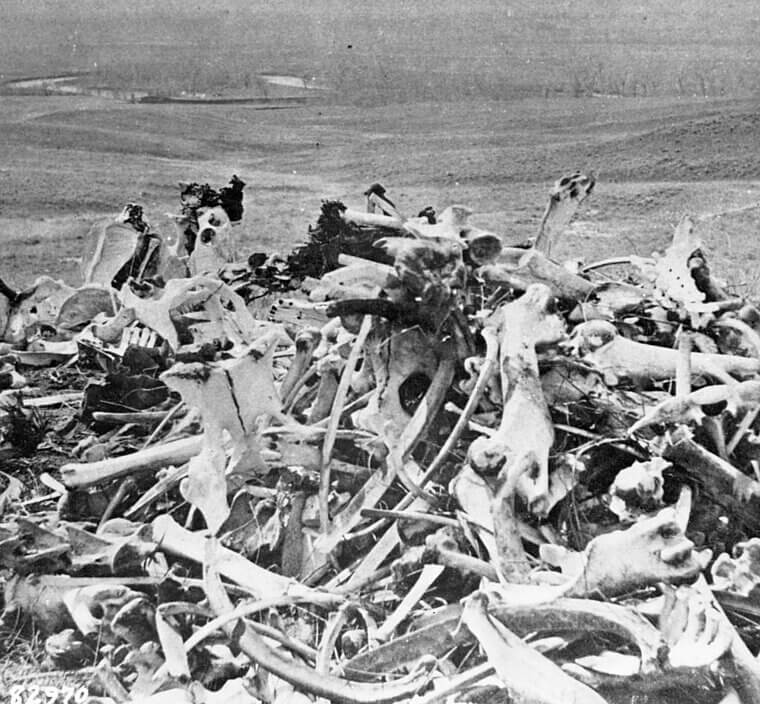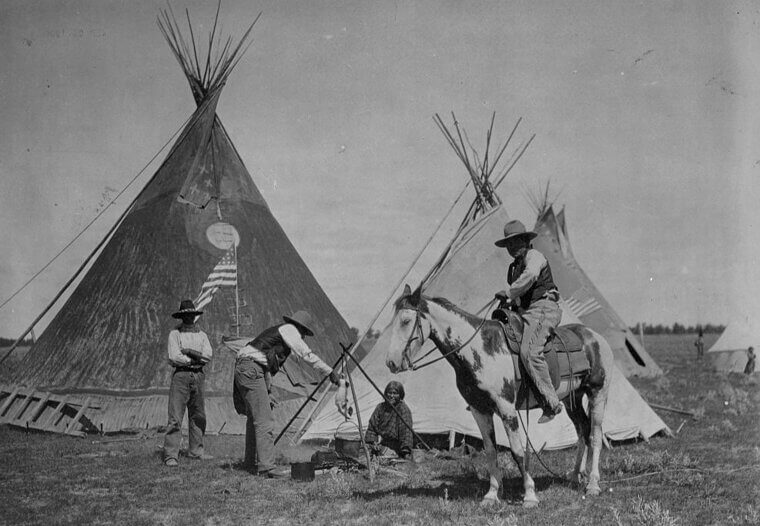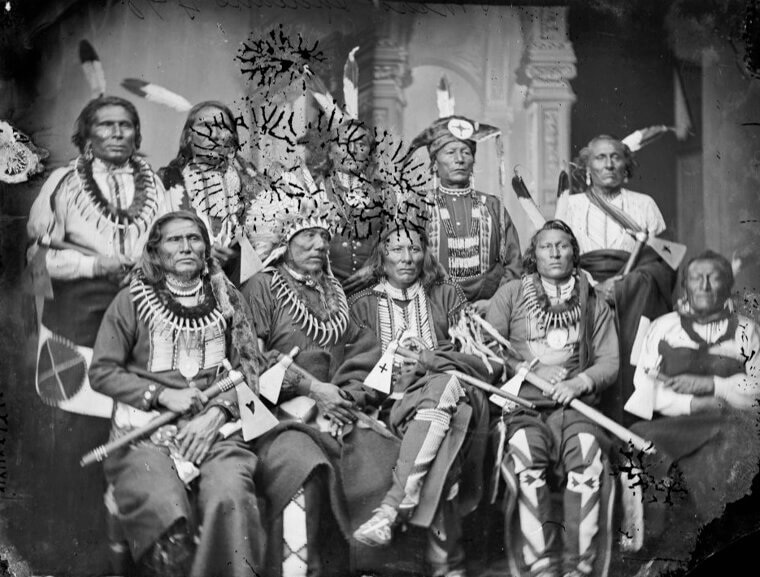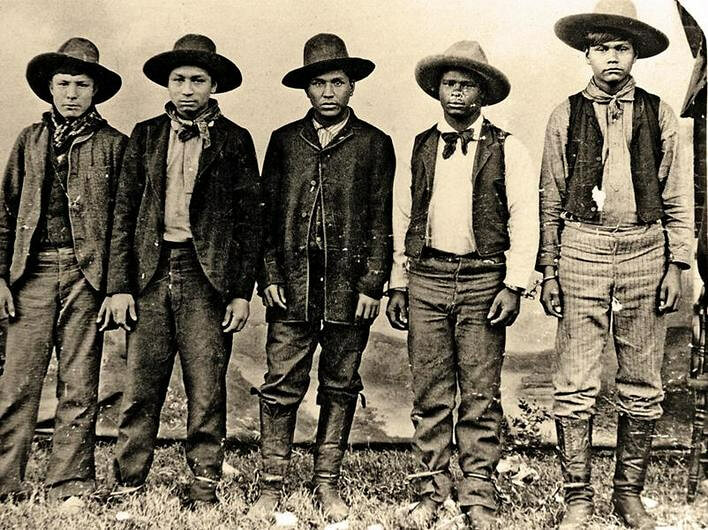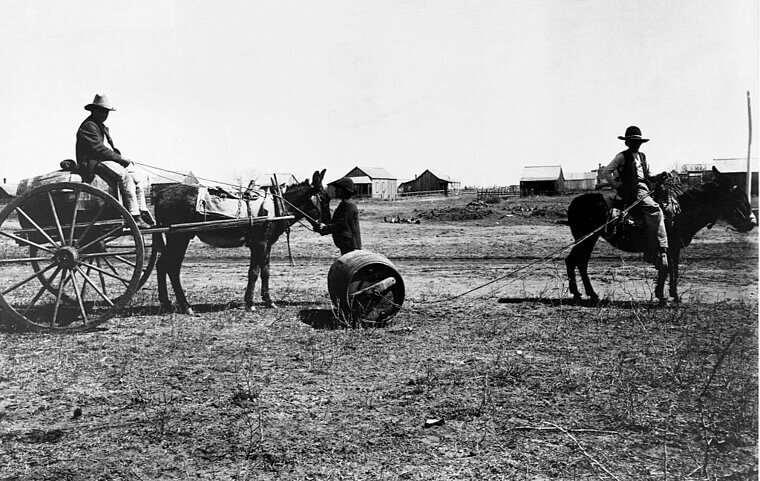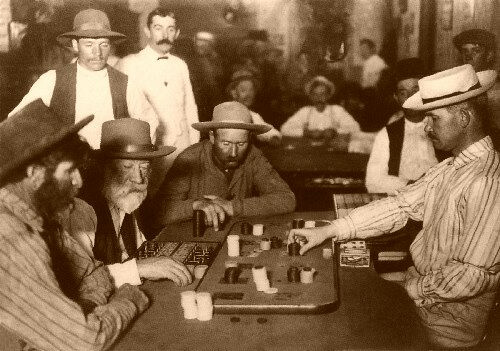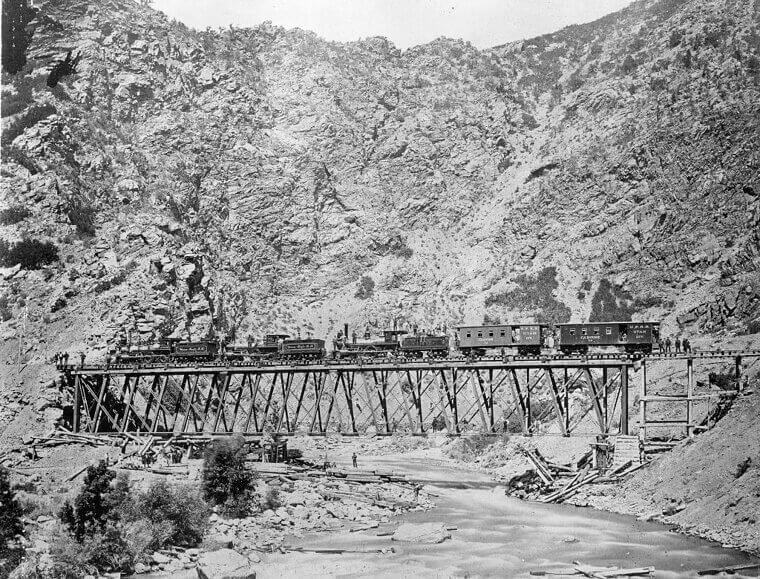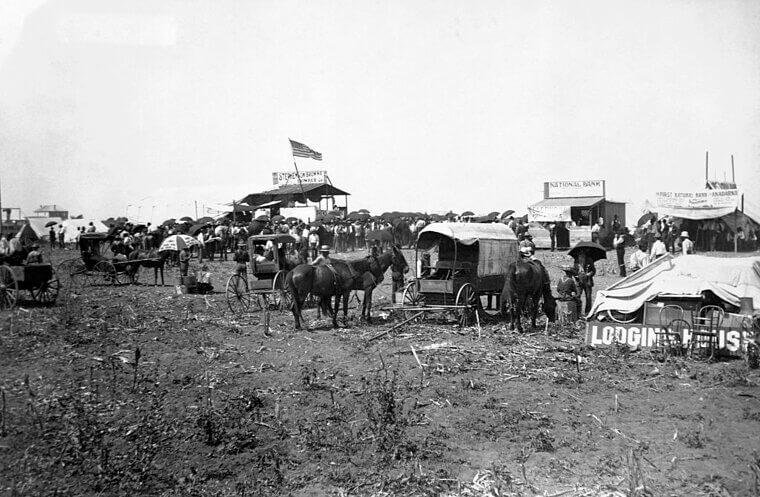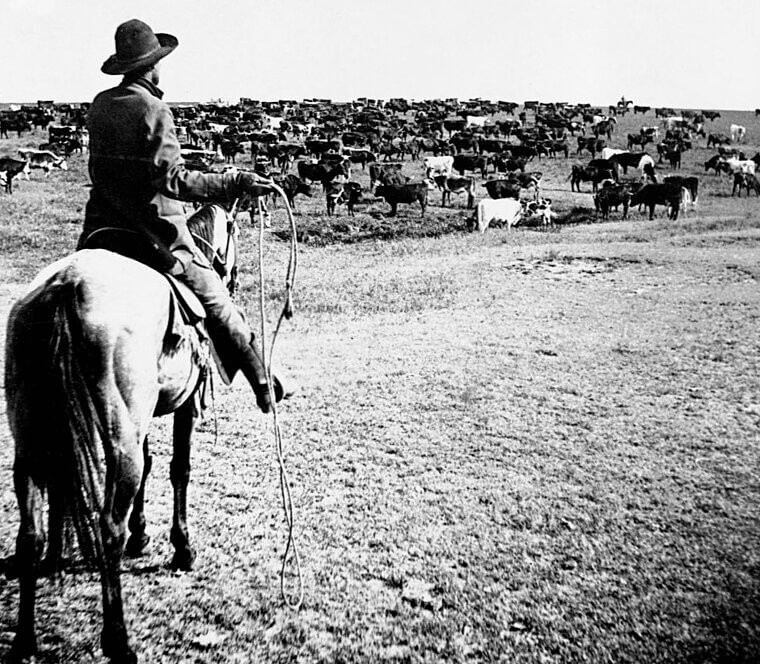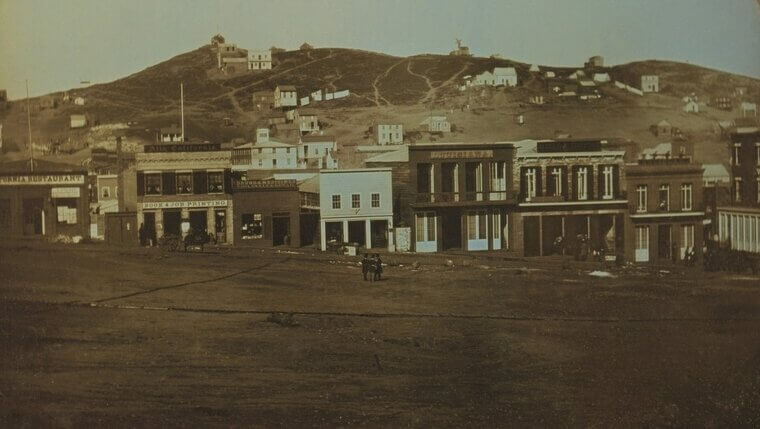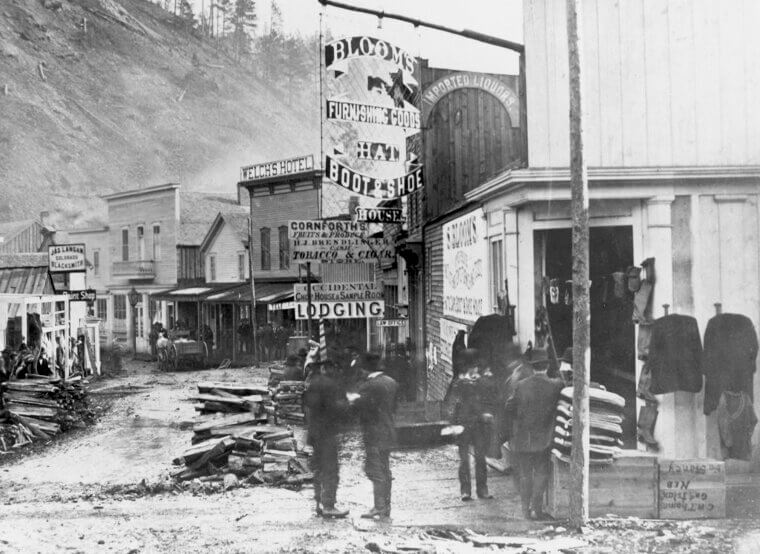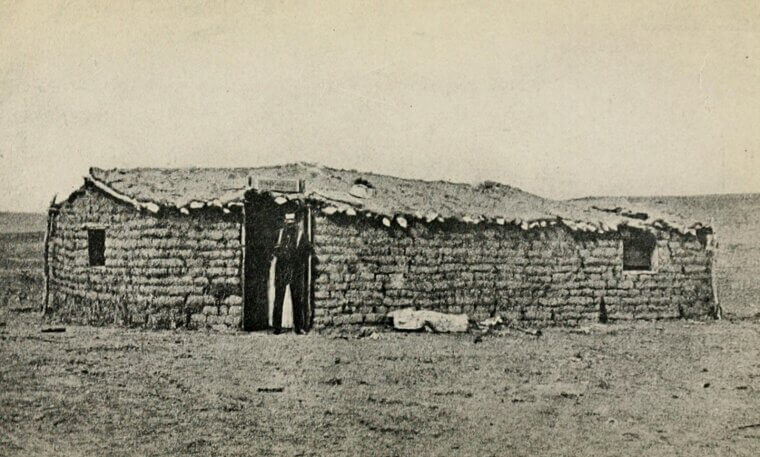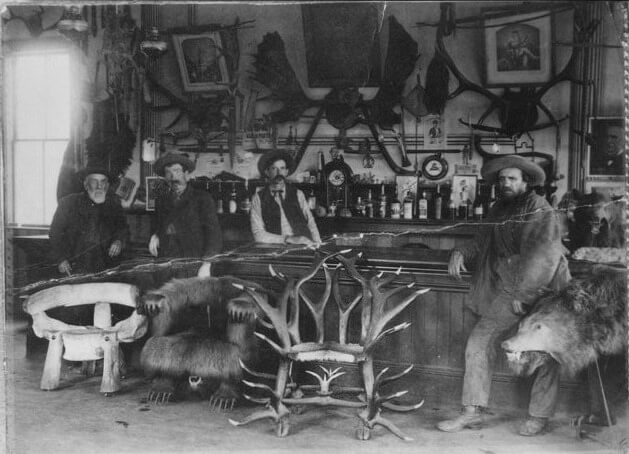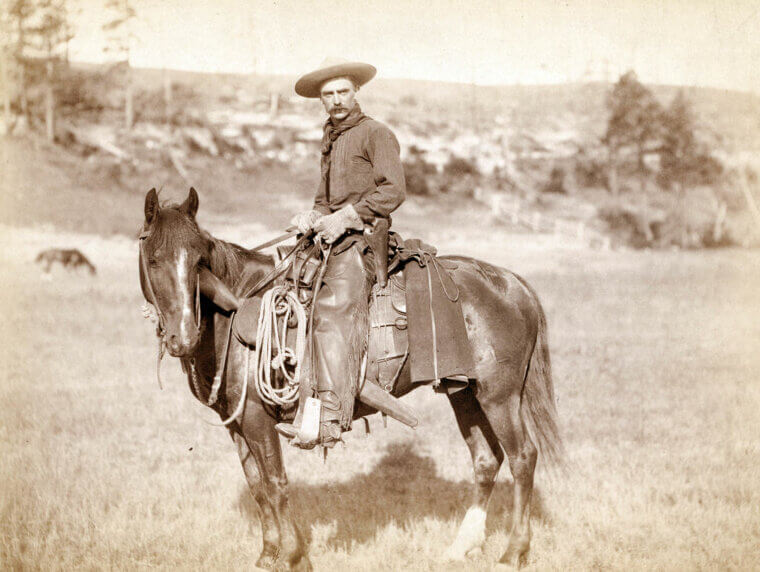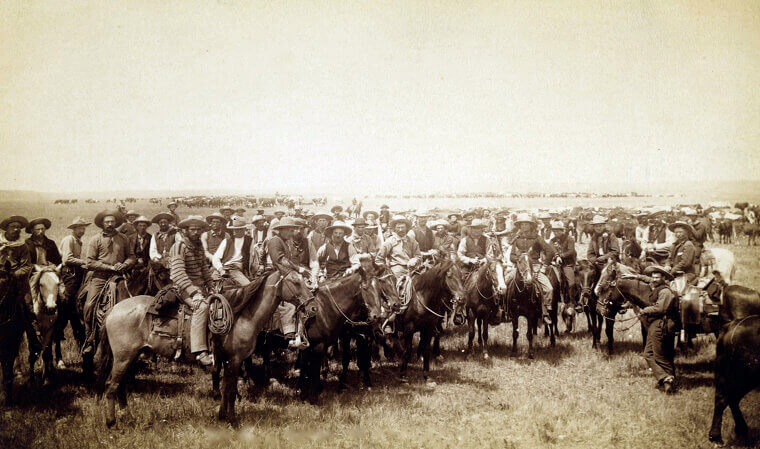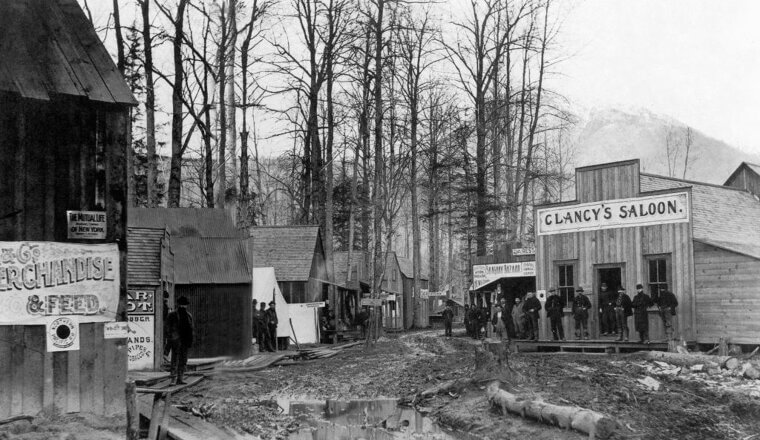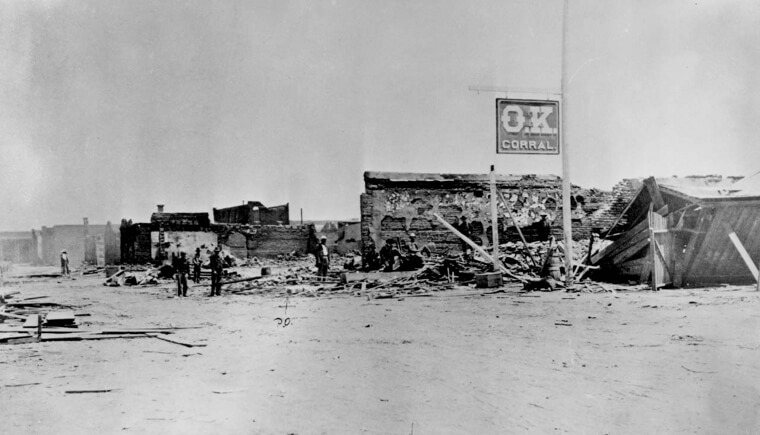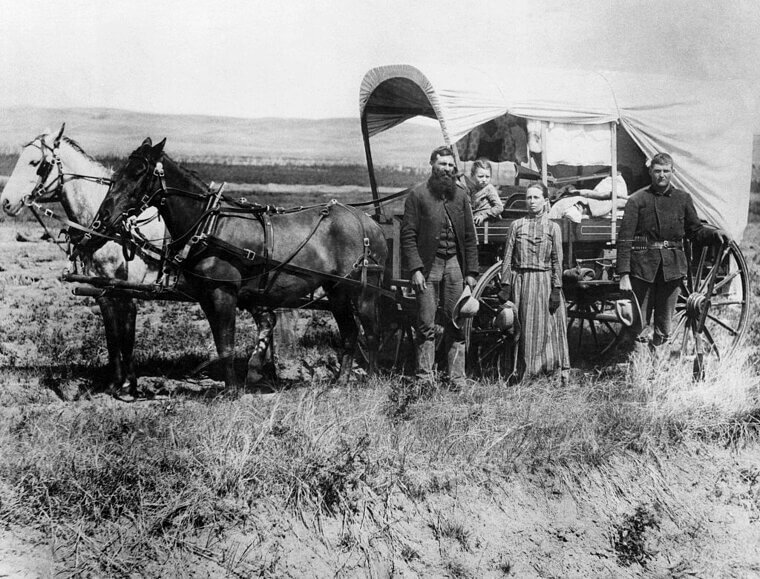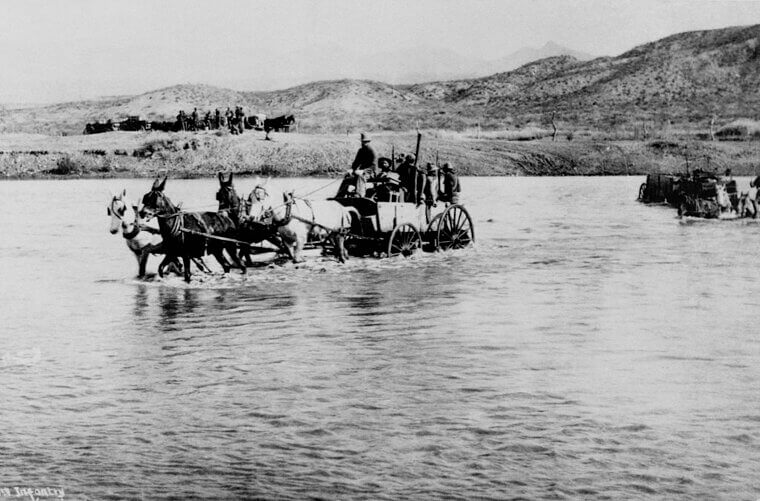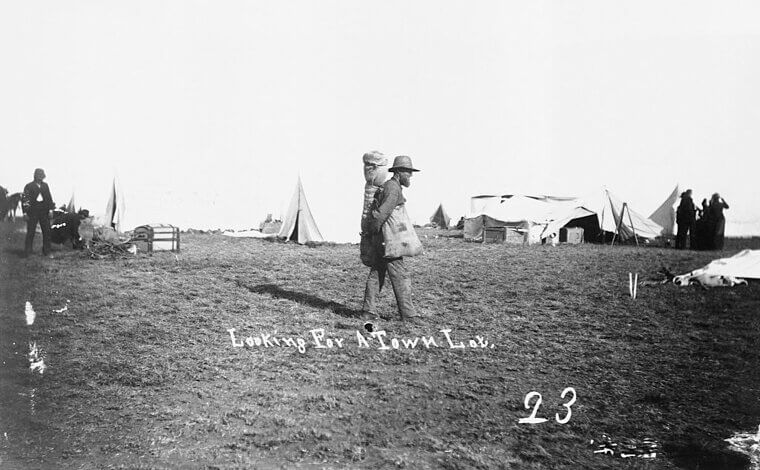An Endless Pile of Bison Skulls
In 1892, a photograph taken in Rogueville, Michigan, shows thousands of bison skulls piled high at the Michigan Carbon Works. These skulls were processed into various industrial products such as glue, dye, ink, fertilizer, and bone char, essential for sugar refining. The mass killing of bison had a profound impact on the ecosystem and the livelihoods of Native Americans, symbolizing the exploitation and industrialization of natural resources during this era.
This image serves as a stark reminder of the Wild West's darker aspects, where the drive for economic gain led to significant environmental and cultural consequences, altering American history irreversibly.
A Photo of Buffalo Bill - The Legend
Buffalo Bill, born William Cody, became a legendary figure in American history for his extraordinary hunting skills, having killed nearly 5,000 bison in eighteen months during the 1860s. His fame as a hunter and frontiersman led him to create Buffalo Bill’s Wild West show in 1883, which captivated audiences with dramatic reenactments of frontier life. This show played a significant role in shaping the popular perception of the Wild West, blending entertainment with historical narrative.
Buffalo Bill's exploits and entrepreneurial spirit embodied the adventurous and often perilous lifestyle of the era, making him an enduring icon of the west coast's colorful history.
The Life of a Homesteader
In the 1800s, homesteaders in the western U.S. were enticed by the promise of substantial rewards under the Homestead Act. Pioneers who successfully cultivated 160 acres of land were granted what would amount to $800K in today's money. This government initiative aimed to populate and develop the Wild West, transforming vast, uncharted territories into thriving communities. The promise of land ownership attracted many, shaping the course of American history and the expansion of the west coast.
These pioneers faced immense challenges, but their perseverance laid the foundation for modern America, turning the Wild West's rugged landscapes into productive and prosperous regions.
The Famous Annie Oakley Shooting Backwards
Annie Oakley, a legendary markswoman, is shown performing a trick shot using a pocket mirror to aim behind her. Her exceptional shooting skills, honed from childhood, earned her fame as the star of Buffalo Bill's Wild West show. Oakley's talents captivated audiences and challenged traditional gender roles, making her a pioneering figure in American history. Her performances highlighted the adventurous and daring spirit of the Wild West, blending entertainment with remarkable skill.
Annie Oakley's legacy endures as a symbol of empowerment and excellence, reflecting the diverse contributions of individuals who shaped the cultural fabric of the west coast and beyond.
Just Some Kids Riding Cows to School
In 1907, the children of rural Okanogan, Washington, displayed remarkable resourcefulness by riding a cow to school due to the absence of buses. This quaint image captures the ingenuity and resilience of families living in one of the last European-settled regions in Washington. The use of a cow for transportation underscores the challenges faced by rural communities in the Wild West, where conventional infrastructure was often lacking, but it does seem functional!
Okanogan served as a vital route to British Columbia, reflecting its strategic importance in the region's development. This snapshot of everyday life offers a glimpse into the inventive solutions adopted by early settlers to navigate their rugged environment.
A Wild Sandstorm in Texas
This 1894 photograph captures a sandstorm about to engulf Midland, Texas, an area known for its booming oil industry. Sandstorms were a common and formidable natural challenge in the West, forcing residents to seek shelter from the fierce winds and blinding dust. These storms posed significant hazards, disrupting daily life and causing damage to property and agriculture. The resilience of the people living in Midland and other parts of the Wild West is evident in their ability to endure such harsh environmental conditions.
This image highlights the intersection of natural forces and human endeavor in the rugged landscape of American history.
Apache Prisoners by the Train
Taken in 1886 near the Nueces River in Texas, this photograph shows Apache prisoners, including the renowned leader Geronimo, on their way to Florida. Many were held at Fort Marion in St. Augustine or relocated to Alabama. The image underscores the harsh treatment and forced relocations faced by Native Americans during this period. The capture and imprisonment of Geronimo and his followers marked a significant event in the history of the Wild West, reflecting the intense conflict between the U.S. government and Native American tribes.
This picture highlights the human cost of westward expansion and the enduring struggle for Native American rights and autonomy.
Auctioning Land in California
In 1904, men gathered in a tent for a land auction in California. Prices for land had risen significantly from the earlier $5 an acre, with some lots selling for around $1,450, equivalent to nearly $50,000 today. These auctions represented the growing demand for property in the burgeoning state. The dramatic increase in land prices illustrates the rapid development and economic opportunities that attracted people to California. It was a good investment at the time!
The photograph of a land auction highlights the speculative nature of land ownership during this period, capturing the excitement and competition among settlers and investors eager to capitalize on the expanding frontier.
They Called Them "disreputable" Places
Hazen, Nevada, founded in 1903, quickly developed a reputation for its saloons and other "disreputable" venues catering to laborers working on a nearby irrigation project. Despite its small population, the town became notorious for frequent hangings, reflecting the lawlessness that often characterized the Wild West. These establishments provided a place for workers to unwind and indulge, contributing to Hazen's economy. However, the prevalence of such venues also highlighted the darker side of frontier life, where vice and violence were commonplace.
Hazen's history offers a glimpse into the chaotic and often brutal reality of life in small Wild West towns during American history.
The First Black Deputy Marshal - A Former Enslaved Person
Bass Reeves, a former enslaved person, became the first Black Deputy Marshal in the late 1800s, operating in what is now Oklahoma and Arkansas. Known for his relentless pursuit of justice, Reeves apprehended 3,000 outlaws, including his son, establishing a legacy as a formidable lawman in the Wild West. His career as a deputy marshal challenged the racial prejudices of the time, showcasing his extraordinary skills and dedication to law enforcement.
Bass Reeves' remarkable achievements and steadfast commitment to justice made him a legendary figure in American history, representing the diverse and often overlooked contributions of Black individuals in the westward expansion.
The Saloon That Caused a Scandal
The Klondyke Dance Hall and Saloon in Seattle, Washington, in 1909 was infamous for "indecent acts" but still managed to generate substantial revenue for the city. This establishment, part of the seedy underbelly of the Wild West, showcased the era's darker side, far from the romanticized tales of adventure. Despite its reputation, the Klondyke was a significant moneymaker, with earnings equivalent to $2.11 million in today's money so they city was happy about it in the end.
Its existence reflects the complex social fabric of west coast cities, where vice and virtue coexisted, contributing to the rich, multifaceted history of American urban life in the early 20th century.
Anti-Saloon League Member Partakes in Destroying 80,000 Bottles of Beer
The Anti-Saloon League, established in the late 1800s, was a prominent force in the temperance movement, aiming to eliminate alcohol consumption in America. This organization faced strong opposition in the saloon-dominated towns of the Wild West, where drinking establishments were integral to social life. Despite the challenges, the League's efforts contributed to the broader push towards Prohibition, reflecting a significant cultural shift in American history. This conflict played a crucial role in shaping the nation's legislative and cultural landscape.
The struggle between temperance advocates and saloon proprietors underscored the societal tensions of the era, highlighting the complex interplay between morality, law, and daily life in the Wild West.
The Grim Reality of Frontier Justice
Public executions were a stark reminder of the harsh realities faced during the Wild West era. This somber scene captures a moment of impending doom, where justice was served with a noose. Life in those times was rugged and unforgiving, with law enforcement often taking drastic measures. The gathered crowd reflects the era’s grim fascination with such spectacles. It was a time when life hung precariously by a thread.
Amidst the romanticized tales of cowboys and adventures, the Wild West also held darker stories. Justice was swift, and sometimes cruel, revealing the true harshness of frontier living.
What It Was Like for Mine Workers to Leave the Shaft
In 1867, Virginia City, Nevada, was a bustling mining town where mills operated non-stop to process valuable ore. This photo of exhausted miners leaving the mine shaft after a grueling day illustrates the harsh realities of life in the Wild West. These workers endured extreme conditions and long hours, driven by the hope of striking it rich. Virginia City's rapid growth and economic boom were fueled by the relentless efforts of these miners, whose labor significantly contributed to the west coast's development.
The image of weary miners highlights the human cost behind the era's prosperity, offering a sobering glimpse into this pivotal chapter of American history.
War Refugees Fleeing for Their Lives
The U.S.-Dakota War of 1862 forced settlers to flee for safety. This image captures their escape from a conflict that resulted in significant loss of life on both sides. The war, fought over land rights in Minnesota, ended with the largest mass execution in American history following a decisive U.S. victory. The photograph of settlers fleeing underscores the unpleasant, intense, and often violent clashes between Native Americans and European settlers.
The Dakota War marked a tragic chapter in American history, highlighting the profound and often devastating impact of westward expansion on both Native and settler communities.
The Building That Was Both a Saloon and a Courthouse
Judge Roy Bean, known as the Law West of the Pecos, held court in Val Verde County, Texas, during the late 1800s. His headquarters, depicted here, served as both a saloon and courthouse in the harsh, remote region of the Chihuahuan Desert, contributing to his legendary status. Bean's unconventional approach to justice and his colorful personality made him a notable figure in the Wild West. His rulings and the unique blend of law and leisure at his establishment reflect the rugged and often eccentric nature of frontier life.
Judge Roy Bean's hangout remains an iconic symbol of the Wild West's unique judicial practices.
Child Labor in the Mines
In the depths of the Wild West, not all workers rode horses under an open sky. Many, including young boys, toiled in the dark, cramped conditions of underground mines. These children were tasked with guiding mules through narrow tunnels, a job both physically demanding and perilously dangerous. The harsh reality of their lives starkly contrasts the romanticized cowboy imagery. Such scenes reveal the often-overlooked struggles of this rugged era.
The use of child labor in mines highlights the challenging and grim aspects of Western expansion. It’s a somber reminder of the harsh realities faced by many.
A Historical Battle - The Battle of Little Bighorn
In 1876, the Battle of Little Bighorn in Montana Territory, also known as Custer’s Last Stand, saw Plains Indians, including the Lakota, Arapaho, and Northern Cheyenne, defeating the U.S. 7th Cavalry Regiment. Led by Crazy Horse, the Natives resisted being forced onto reservations, achieving a significant but temporary victory. This battle marked a pivotal moment in the conflict between the U.S. government and Native American tribes, highlighting the intense struggle for land and sovereignty.
The victory at Little Bighorn stands as a testament to the resilience and determination of the Native American warriors, profoundly impacting the course of American history in the Wild West. But this photo of a pile of bones shows the dark side of battle.
American and Indigenous Cultures Combining in the Wild West
In 1906, a Gros Ventre encampment was photographed at Fort Belknap, Montana, featuring traditional tipis and American flags. This image captures the intersection of indigenous culture and American influence during the Wild West era. The Gros Ventre, along with the Assiniboine, reside on the Fort Belknap Reservation today, continuing their rich cultural traditions. This photograph serves as a historical record of the Gros Ventre's way of life, highlighting their resilience and adaptability.
The presence of American flags amidst the tipis symbolizes the complex relationship between Native American tribes and the expanding United States, reflecting a pivotal moment in west coast history.
A Stunning Photo of Tribal Chiefs
This 1865 photograph features Native American chiefs from the Ponca Indian Delegation in the Western U.S. The Ponca Tribe, later subjected to the Trail of Tears, experienced profound suffering and displacement. The image captures a poignant moment of dignity and leadership amidst the impending hardships their people would endure. This era in American history was marked by the forced relocation and systemic oppression of Native Americans, highlighting the darker side of westward expansion.
The photograph stands as a testament to the resilience and strength of the Ponca leaders, who faced tremendous challenges while striving to protect their people's heritage and land.
The Rufus Buck Gang Before They Were Executed
Active from 1895 to 1896, the Rufus Buck Gang, composed of Black and Creek Indian members, committed a series of crimes in Indian Territory near Oklahoma. Captured and executed at Fort Smith, they were unique for being the only individuals executed for a non-capital crime by Judge Isaac C. Parker’s court. Their brief but violent spree highlights the complexities of law and order in the Wild West, where diverse groups often clashed with legal authorities.
The story of the Rufus Buck Gang underscores the turbulent and often lawless nature of the American frontier, illustrating the harsh realities of justice during this period in American history.
The Difficulties of Getting Water in the Wild West
In 1905, this photograph illustrates the challenging task of hauling water in Texas. With limited natural water sources, residents relied on wells and sought out nearby supplies, transporting water by horse-drawn wagons, a necessity in the arid climate of the Wild West. The labor-intensive process of securing water highlights the daily hardships faced by settlers and the ingenuity required to survive in such an environment. This image captures the essence of frontier life, where basic necessities like water required significant effort and resourcefulness.
Hauling water was a crucial aspect of life in the Wild West, shaping the daily routines and survival strategies of its inhabitants.
A Group of Men Playing Faro in a Western Saloon
In 1895, men are depicted playing Faro in a Western saloon. This French gambling game, popular during the Gold Rush era, was a common pastime until around 1915. Faro's decline began by 1925, surviving in only a few Nevada casinos, but it was a staple of Western saloon life, often leading to high-stakes conflicts. The game was known for its simplicity and the excitement it generated among players, embodying the risk-taking spirit of the Wild West.
The image of men engrossed in a game of Faro captures a slice of daily life during this period, reflecting the social dynamics and entertainment of the time.
The Beginning of an Era - The Transcontinental Railroad
The Transcontinental Railroad, completed in 1869, was a monumental engineering achievement that connected San Francisco Bay with Bluffs, Iowa, spanning 1,911 miles. This massive project cost $60 million and claimed thousands of workers' lives due to harsh working conditions. The railroad's completion revolutionized transportation and commerce, facilitating the west coast's rapid development and integration into the national economy. It symbolized the relentless drive for progress that characterized the era, despite the significant human cost.
The construction of the Transcontinental Railroad stands as a testament to the ingenuity and determination that shaped American history, transforming the landscape and economy of the Wild West.
What Entailed Settling a New Town
Anadarko, Oklahoma, pictured in 1901 during its early development, is known as the “Indian Capital of the Nation.” It became home to several Native tribes, including the Delaware Nation and the Wichita and Affiliated Tribes, reflecting the area's deep indigenous roots and cultural significance. The establishment of Anadarko illustrates the complex interactions between Native American communities and European settlers during the westward expansion. There were many clashes as could be imagined.
The photograph of the town's early days captures the spirit of building and growth that characterized this period, while also acknowledging the rich cultural heritage of the Native tribes that continue to shape the region's identity.
Just a Cowboy With His Cows
A cowboy at Sherman Ranch in Kansas herds cows, embodying the relentless labor of the era. In 2023, the cost of a cow ranges from $1,900 to $2,300, a stark contrast to the mere $4 to $7 each in the 1900s. This price difference underscores the evolution of the cattle industry and its economic impact on American history. Cowboys played a crucial role in this industry, enduring long, demanding days to manage the herds.
The stark economic comparison highlights the historical context and financial hardships faced by those who shaped the Wild West's cattle trade.
The History of Corinne, Utah
Corinne, Utah, was a unique haven in the Wild West, offering safety for people of all religions. This town almost became the capital of Utah, reflecting its historical significance and inclusive atmosphere. Early photos of Corinne depict its nascent days, capturing a pivotal moment in American history. Unlike many other Wild West towns, Corinne's commitment to religious tolerance set it apart, fostering a diverse and harmonious community. The town's ambition to become the state capital further underscores its importance in the west coast's development.
These historical glimpses reveal a town striving for prominence and unity amidst the tumultuous backdrop of the era.
San Francisco and the Gold Rush
In the mid-1800s, the Gold Rush rapidly transformed San Francisco, drawing an influx of 300,000 hopeful miners to the area. This surge in population sparked a remarkable transformation, turning the city into a bustling hub of activity. Hotels, saloons, stores, and makeshift tent houses sprang up almost overnight, catering to the needs of the diverse and often desperate population. The Gold Rush era left an indelible mark on San Francisco's landscape and history, with the city's rapid growth and vibrant culture reflecting the dynamic spirit of the time.
This period of explosive development solidified San Francisco's place in American history as a symbol of opportunity and ambition.
Deadwood Wasn't Really so Dead
Deadwood, South Dakota, renowned for its Gold Rush history, serves as the final resting place of notable Wild West figures Wild Bill Hickok and Calamity Jane. Despite its small population of only 1,201 residents, Deadwood attracts numerous tourists eager to explore its rich historical significance. The town's legacy as a vibrant Gold Rush hub remains evident in its well-preserved architecture and historical landmarks.
Visitors to Deadwood can walk the same streets that once bustled with prospectors and outlaws, gaining a deeper appreciation for this iconic chapter of American history. The allure of Deadwood lies in its authentic representation of the Wild West's tumultuous past.
The First Home in Dodge City - A Historical Landmark
Dodge City, Kansas, founded in 1875, quickly became a landmark in the Wild West with historical sites such as the Fort Dodge Jail and Boot Hill Museum. The city's first home, constructed in 1871, was a humble sod house, marking the beginning of its development. This modest dwelling symbolized the rugged determination of early settlers who braved the frontier's challenges. As Dodge City grew, it evolved into a bustling center of commerce and law enforcement, playing a crucial role in the westward expansion of the United States.
The city's origins, encapsulated by its first home, reflect the pioneering spirit that shaped American history.
Getting a Look at the Table Bluff Hotel and Saloon
The Table Bluff Hotel and Saloon in California, owned by the colorful figure Seth Kinman, was a central establishment in the late 1800s. This venue served as a social and economic hub for the community, offering lodging and entertainment to travelers and locals alike. Kinman's hotel later became part of the 1970s evangelical Jesus Movement, marking a unique transition in its history. This shift from a rowdy frontier establishment to a site of religious revival illustrates the dynamic and evolving nature of the west coast's historical landscape.
The Table Bluff Hotel and Saloon encapsulates the diverse cultural influences that have shaped the region over time.
Living as a Cowboy Was Not Always Glamorous
Living as a cowboy in the Wild West was not always glamorous. These men, often romanticized in American history, spent their days herding cattle and working tirelessly on ranches across the vast western U.S. regions. The daily grind was grueling, with cowboys facing extreme weather, long hours, and the constant threat of injury. The west coast's rugged terrain added to their challenges, making every task a test of endurance and resilience.
This unseen photo reveals a more accurate portrayal of cowboy life, challenging the myth of the carefree, adventurous cowboy and highlighting the harsh realities of survival in the Wild West.
The Look of a Real Cowboy
Cowboy attire in the late 1800s, including spurs, chaps, hats, and vests, was designed for practicality and comfort during horseback riding. This gear was essential for coping with the extreme weather and rugged conditions of the Wild West. Spurs provided better control over horses, while chaps protected legs from thorny brush and harsh elements. The iconic cowboy hat offered shade and protection from the sun and rain. While modern fashion often romanticizes cowboy attire, its original purpose was rooted in necessity.
This practical clothing enabled cowboys to perform their demanding tasks effectively, reflecting the adaptive ingenuity that defined the west coast's frontier spirit.
Rugged Frontier Lifestyle in Clancy's Saloon
Clancy’s Saloon in Skagway, Alaska, pictured in 1897, epitomized the remote and rugged frontier lifestyle of the Wild West. Skagway was a pivotal location during the Klondike Gold Rush, attracting thousands of prospectors seeking fortune. Clancy's Saloon provided a vital social hub for these adventurers, offering respite and camaraderie amid the challenging conditions. The town's preserved historical buildings, including Clancy’s, offer a tangible link to this vibrant era in American history.
Skagway's enduring charm lies in its ability to transport visitors back to the days of the Gold Rush.
Early Images of the OK Corral and After a Fire
In 1882, a year after the famous gunfight, the OK Corral in Tombstone, Arizona, was photographed following a devastating fire. Known for its notorious saloon and outlaw showdowns, the Corral was rebuilt and remains a historical site where visitors can experience reenactments of its storied past. The OK Corral symbolizes the lawlessness and violence that were prevalent in the Wild West. The fire and subsequent reconstruction illustrate the resilience of the people who lived during this tumultuous time in American history.
The site continues to attract tourists, eager to witness a piece of the legendary cowboy culture and Wild West lore.
Apaches and Settlers Trading in Peace
In 1893, Apaches were photographed delivering hay to pioneers at Fort Apache, Arizona, demonstrating their trade interactions with settlers. This image captures a moment of peaceful exchange, contrasting with the more turbulent aspects of their history. While some Apache bands engaged in raiding, which they did not view as acts of war, others participated in trade to coexist with settlers. This duality reflects the complex relationships between Native American tribes and pioneers during the Wild West era.
The photograph of Apaches delivering hay serves as a reminder of the diverse and multifaceted interactions that shaped the west coast's historical landscape.
The Great Migration - What It Looked Like as an Individual Family
In 1886, a family in Loup Valley, Nebraska, participated in the Great Western Migration, which began in 1841. The journey westward was fraught with dangers like disease, Native attacks, and accidents. Despite these risks, many families braved the hardships in pursuit of new opportunities in the Western U.S. The photograph of a migrating family encapsulates the hope and determination that drove thousands to seek a better life on the frontier.
This picture highlights the resilience and fortitude required to undertake such a perilous journey, reflecting the broader narrative of exploration and settlement that defined American history in the Wild West.
The Difficulties of Crossing the Gila River
In 1885, this image shows a cowboy crossing the Gila River in San Carlos, Arizona. The river, a significant tributary through Arizona and New Mexico, presented challenges with its unpredictable waters. The area includes the San Carlos Apache Reservation, highlighting the diverse and often perilous landscape of the West. The cowboy's journey across the Gila River exemplifies the daily hardships faced by those living in the Wild West.
Navigating such natural obstacles was part of the rugged frontier life, where resourcefulness and resilience were essential. This photograph captures a moment that reflects the broader struggle and adventure of settling the western territories.
The Lookout for a Place to Build a Home
In 1889, a settler in Guthrie, Oklahoma, searches for land to build a home. Land cost about $5 an acre, with building costs ranging from $300 to $700, making land acquisition and home construction affordable compared to modern standards, driving the rapid settlement of the West. This period saw a massive influx of settlers eager to claim and cultivate new land, spurred by government policies like the Homestead Act.
The photograph of a settler seeking a lot encapsulates the optimism and determination that fueled the westward migration, reflecting the broader American dream of opportunity and prosperity on the frontier.
The Buffalo Soliders and Their Role in Expansion to the West
Formed in the mid-1880s at Fort Leavenworth, Kansas, the 10th Cavalry Regiment, known as the Buffalo Soldiers, faced harsh conditions and racism. They fought bravely in numerous battles, earning their nickname from Native Americans who respected their fierce fighting style and resilience. The Buffalo Soldiers played a crucial role in the westward expansion, participating in significant military campaigns and helping to build infrastructure. Their contributions to American history are a testament to their courage and perseverance in the face of adversity.
The legacy of the Buffalo Soldiers highlights the important and often overlooked role of African American troops in shaping the Wild West.
